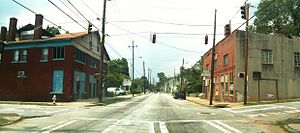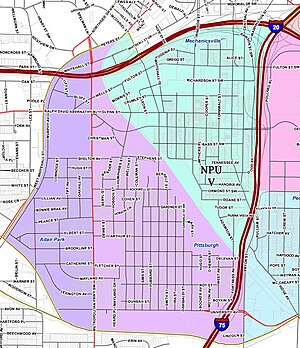Pittsburgh Historic District | |
| Location | Roughly bordered by Shelton Ave. Stewart Ave., University Ave., and the RR, Atlanta, Georgia |
|---|---|
| Coordinates | 33°43′45.56″N 84°24′5.88″W / 33.7293222°N 84.4016333°W |
| Area | 324 acres (131 ha) |
| Architect | A. Ten Eyck Brown |
| Architectural style | Tudor Revival, Bungalow/Craftsman |
| NRHP reference No. | 06000503[1] |
| Added to NRHP | June 14, 2006 |
Pittsburgh | |
|---|---|
 McDaniel Street in Pittsburgh | |
 Pittsburgh (light purple) within southwest Atlanta | |
| Coordinates: 33°43′45.56″N 84°24′5.88″W / 33.7293222°N 84.4016333°W | |
| Country | United States |
| State | Georgia |
| County | Fulton County |
| City | City of Atlanta |
| NPU | V |
| Population (2000)[2] | |
| • Total | 3,286 |
| ZIP Code | 30310 |
| Website | Pittsburgh Community Improvement Association |
Pittsburgh is a neighborhood of Atlanta, Georgia, founded in 1883 as a Black working-class suburb alongside the Pegram rail shops. It was named Pittsburgh because the industrial area reminded one of Pittsburgh, Pennsylvania and its famous steel mills. Pittsburgh is a working class and developing neighborhood, and as property values rise in Intown Atlanta neighborhoods, many see possibility that this trend will spread to Pittsburgh while bringing renewal for legacy residents.
- ^ "National Register Information System". National Register of Historic Places. National Park Service. July 9, 2010.
- ^ a b "Pittsburg". Archived from the original on September 5, 2006. Retrieved June 19, 2010.


